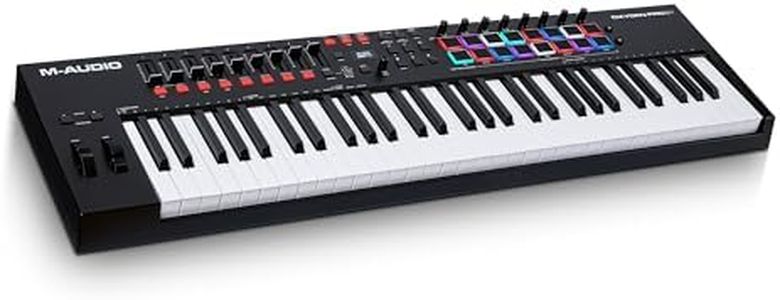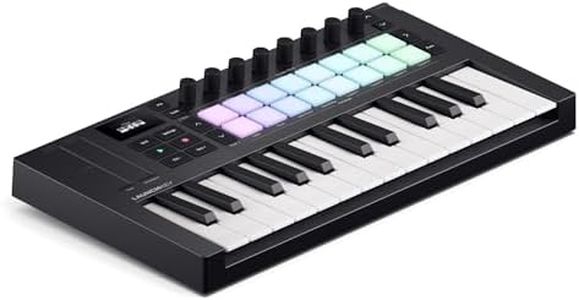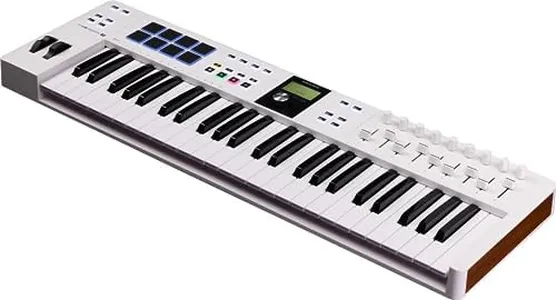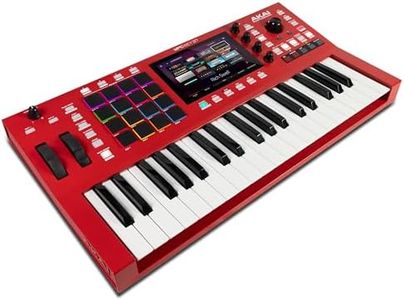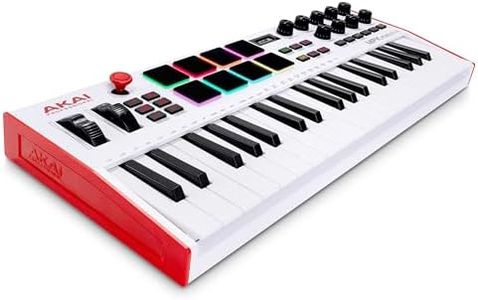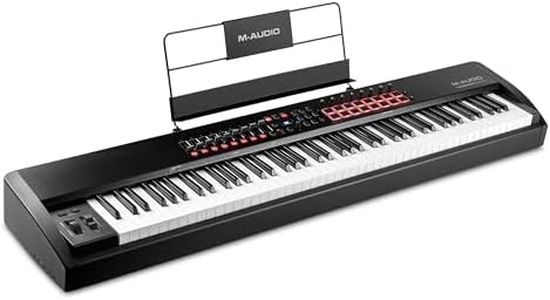Top 10 Midi Keyboards Deals Right Now
Akai Professional MPC Key 61 - Standalone Music Production Synthesizer Keyboard with Touch Screen, 16 Drum Pads, 20+ Sound Engines, Semi Weighted Keys, and Native Instruments Integration
Our technology thoroughly searches through the online shopping world, reviewing hundreds of sites. We then process and analyze this information, updating in real-time to bring you the latest top-rated products. This way, you always get the best and most current options available.

Our Top Picks
Akai Professional MPC Key 61 - Standalone Music Production Synthesizer Keyboard with Touch Screen, 16 Drum Pads, 20+ Sound Engines, Semi Weighted Keys, and Native Instruments Integration
Most important from
104 reviews
The Akai Professional MPC Key 61 is a versatile and powerful standalone music production keyboard suited for professional electronic musicians and producers seeking an all-in-one solution without relying on a computer. It features 61 semi-weighted keys with aftertouch, providing a balance between expressiveness and playability, especially for synth and electronic styles. A 7-inch multi-touch screen, 16 MPC pads, assignable touch strip, and multiple control knobs offer hands-on control over sounds and effects, enhancing intuitive and creative workflow.
Connectivity options include USB, Wi-Fi, Bluetooth, and support for MIDI devices and CV/Gate synths, allowing flexible integration with other gear and software. The MPC Key 61 supports a wide range of software, including major Digital Audio Workstations on Windows and Mac, plus Native Instruments integration to expand creative possibilities. With over 20 sound engines and more than 6000 customizable sounds onboard, it provides a rich palette of tones ranging from drums to orchestral instruments.
In terms of build, it is fairly portable despite its 17.88-pound weight and robust enough for studio and stage use, although heavier compared to simpler MIDI controllers. Storage expandability through an internal SSD slot and 32GB built-in memory enhance its standalone capabilities. While pricier and more complex than basic MIDI keyboards, and constructed with plastic that may not satisfy those seeking a premium feel, the MPC Key 61 is well-suited for professionals who need a standalone, feature-rich production keyboard with extensive controls and sounds, but it might be more than casual players or simple MIDI controller users require.
Most important from
104 reviews
Great Choice
Alesis 88 Key Keyboard Piano with 480 Sounds, Speakers, USB MIDI, Carry-Bag, Stand, Headphones, Pedal and Piano Lessons for Beginners
Most important from
1545 reviews
The Alesis 88 Key Keyboard Piano is a great option for beginners looking to learn and practice the piano. It features 88 full-size, touch-sensitive keys, providing an experience similar to an acoustic piano, which helps in building finger strength and dexterity. The keyboard is lightweight and portable, allowing you to practice anywhere with either the included power adapter or 6 AA batteries (not included). It also comes with a complete accessory bundle, including a stand, headphones, a sustain pedal, and a carry case, making it convenient for those starting out.
The built-in speakers deliver rich sound, enhancing the playing experience. With a massive sound library of 480 realistic sounds, 160 rhythms, and 140 demo songs, you have a wide range of options to explore and create music. The educational features such as Split, Lesson, and Record Modes are especially useful for students and teachers to practice together. The USB-MIDI connectivity allows you to connect the keyboard to a Mac or PC, enabling the use of various recording and educational software, which is ideal for furthering your piano education.
While the keyboard's lightweight nature is beneficial for portability, it might feel less sturdy compared to some heavier models. Additionally, the touch-sensitive keys, while good, may not fully replicate the feel of a high-end acoustic piano. Despite these minor drawbacks, the Alesis 88 Key Keyboard Piano offers excellent value for beginners with its extensive features and included accessories.
Most important from
1545 reviews
Native Instruments S-Series Komplete Kontrol S61 MK3 Keyboard Controller
Most important from
104 reviews
The Native Instruments Komplete Kontrol S61 MK3 is a solid choice for musicians and producers looking for a high-quality MIDI keyboard. It features 61 semi-weighted keys, which provide a responsive and expressive playing experience. The inclusion of polyphonic aftertouch adds an extra layer of control, making it suitable for intricate performances. Its high-resolution full-color screen is a standout feature, aiding in intuitive browsing and tweaking of sounds, which is particularly useful for in-depth music production tasks.
The keyboard's build quality is impressive, with a combination of metal and glass elements giving it a sturdy and elegant feel. However, at 13.22 pounds, it is slightly on the heavier side, which might be a consideration if portability is a priority for you. Connectivity is limited to USB, which is standard but might feel restrictive for those needing more varied options.
Software compatibility is strong, supporting popular programs like Ableton Live, Avid Pro Tools, and FL Studio, allowing seamless integration into most production setups. On the downside, some users might find the 61 keys limiting if they require a full keyboard range. If you need a reliable, well-built MIDI keyboard with excellent software integration and advanced features, the S61 MK3 is worth considering.
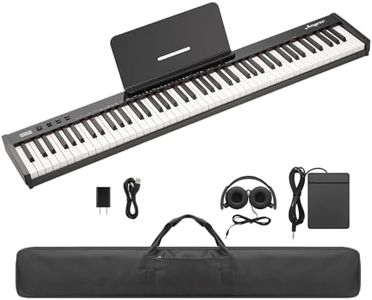





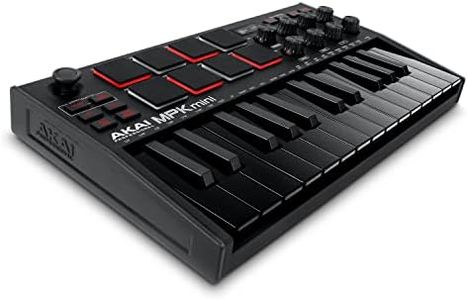
![Case Compatible with Otamatone [English Edition] Japanese Electronic Musical Instrument Portable Synthesizer, Instrumental Music Toy Storage Holder for Otamatone Regular Size (Box Only) (White)](https://images-proxy.bestreviews.guide/0MjSoBfJ9PWf-Jzi673cYrZ_S5A=/0x300/https://m.media-amazon.com/images/I/51IZUiDnynL._AC_CX679_.jpg)


